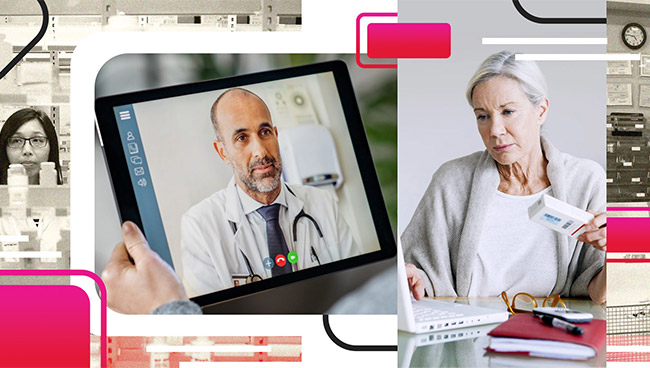As pharmacists became distracted by other tasks that took them out-of-sight from behind the counter, shoppers increasingly turned to more accessible sources for advice. Our How America Shops® research explores the growing acceptance of online pharmacies, which challenge retailers to find their way back to their Rx shoppers.
Shoppers Want Wellness Advice, But They Won’t Wait in Line
The in-store pharmacist was once shopper’s first destination for wellness advice. Yet over the years pharmacists became occupied with managing insurance claims, counting pills and other tasks that remove them as the first line of shopper interaction. The pandemic and demand for Covid tests, vaccinations and support further overwhelmed pharmacy departments.
As a result, the person at the counter today might be a pharmacy technician, student or retail sales associate, but based on our research, that person is no longer someone shoppers trust for medical advice.
Enter the Internet. Sites like WebMD, Mayo Clinic and Cleveland Clinic have long delivered the answers shoppers seek. Then customized vitamin and other pioneering treatment sites launched the migration of shoppers to online Rx sites, giving shoppers reasons not to visit big-name stores.
These online pharmacies are now expanding their services from Rx fulfillment to advice, and even writing scripts where they can – without the wait. Just look at how adept Amazon Pharmacy has become at gaining trust, because it makes it all so easy, fast and affordable.
Consider these findings from our recent How America Shops® WELL research:
- Just 33% of all shoppers now consult the in-store pharmacist for WELLness advice, and 26% consult with the pharmacist on treatments.
- While the overall percentage of shoppers who consult online pharmacists is lower – 18% for wellness guidance – the figures scale much higher among Gen Z and Millennials:
- One-fourth of Gen Z and Millennial shoppers use an online pharmacist for health guidance.
These figures predict that the direction of future pharmacy interactions, including sales, are headed online. And that will come at a cost, unless retailers step in.
3 Ways to Remedy the Virtual Pharmacy Conundrum
Virtual pharmacists were a necessity during the pandemic, but now it’s necessary to bring those shoppers back into the store and use the two channels collaboratively. It’s the only way shoppers will make in-store purchases they might not think of during a virtual consultation.
Here’s how to ensure the future of the retail pharmacy, and pharmacists, becomes a bigger part in the shoppers’ quest for WELLness.
- Think beyond the Rx. Just 37% of Millennials consider a medical doctor as the best source for wellness and treatment. This underscores the opportunity for in-store pharmacy. For example, to direct shoppers to its pharmacies, grocery chain Hy-Vee has nailed the opportunity, by placing a W Nail Bar, a boutique salon, directly next to the pharmacy at two future-store locations in Iowa.
- Provide specialist offerings that encourage real face time. While just 26% of shoppers consult the in-store pharmacist for guidance on treatment, that figure hints at a potential emerging trend. At Sam’s Club pharmacies, shoppers can get cholesterol and blood glucose screenings, encouraging them to engage with the pharmacy staff on their readings and, potentially, treatments. Then, as a next step, Sam’s telehealth app enables members to see a doctor virtually.
- Make it visibly more accessible. One-fifth of shoppers now consult online pharmacists for both treatment and wellness. This indicates trust that may have been fostered during the pandemic. That trust can be duplicated in the store if access to the pharmacist is effortless. At Rite Aid’s RxEvolution test stores in Pennsylvania and New Hampshire, the layout builds trust by bringing the pharmacist out from behind the counter for easier, more personal accessibility.
Here’s How to Treat WELL Shoppers Better
This is how we see it: Shoppers are more willing to consult an online retail pharmacist than an in-store pharmacist because it is faster and easier than going in store and waiting in line. And retailers are encouraging this pharmacy trend, by sending shoppers to virtual pharmacists for immediate consultations and chats.
But those virtual chats do not lead to the kinds of impulse purchases (or even recommended but overlooked purchases) that would occur in the store. Shoppers need to want to visit the pharmacy. If you can’t think of a reason why they would want to seek that experience at your stores, then swallow your medicine and create that reason, or learn to live with the side effects.
There are many ways to ensure your retail experience meets all your shopper needs, from health to personal values. To learn the latest in shopper sentiment regarding WELLness, and to see what your retail and brand peers are doing to meet those preferences, visit our dedicated WELL microsite.


